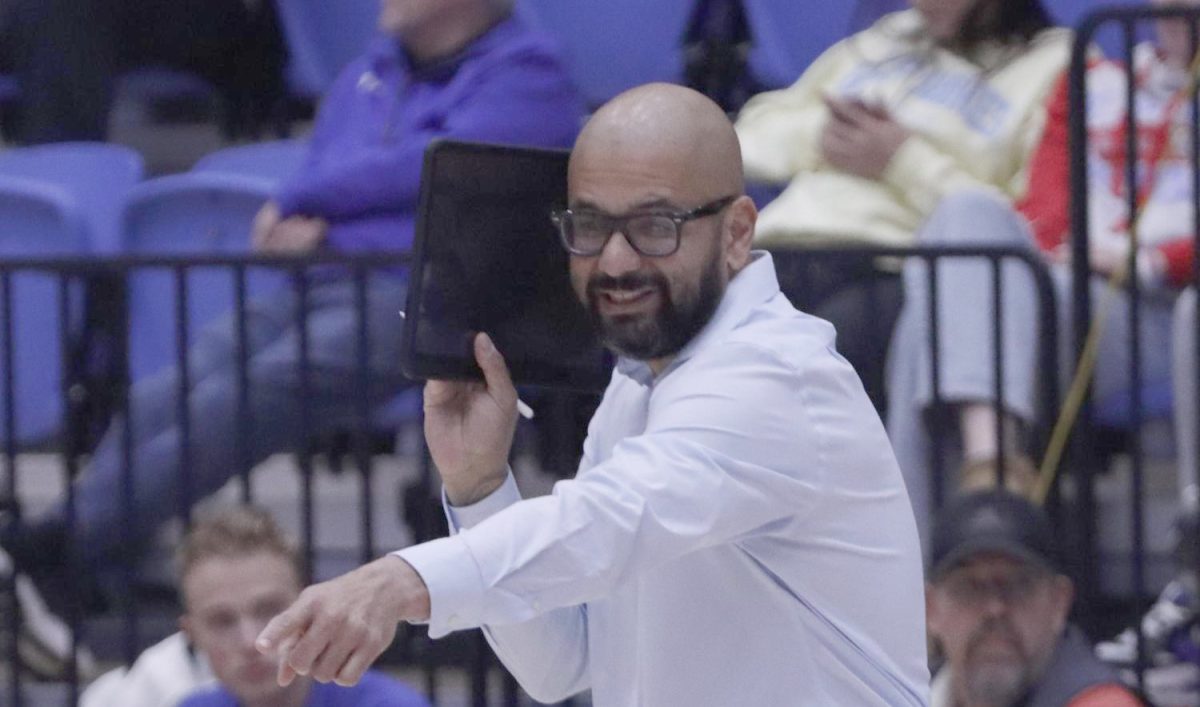Jennings speaks about real hope
When Cedric Jennings walked onto stage, it was hard to imagine him as a stubborn, sometimes antisocial teenager.
Wearing black Calvin Klein glasses, a blue button-up shirt and a black sweater, Jennings confidently approached the podium.
“Woooo!” he yelled. “I never thought I would be able to make it to the cornfields of Illinois. In fact, I didn’t even know Illinois had cornfields!”
As the saying goes, he “had the audience at, ‘Hello.'”
Jennings spoke to students, faculty and community members Monday night in McAfee Gymnasium about his experiences growing up in a rough Washington, D.C. neighborhood and going on to attend Brown University, an Ivy League school.
Jennings was the subject of Ron Suskind’s “A Hope in the Unseen,” the first book selected for Eastern’s summer reading initiative.
As a top student at Ballou High School in D.C., Jennings quickly learned not to speak of his aspirations or achievements. Standing out academically meant being ridiculed and sometimes even threatened.
Towards the end of his junior year of high school, Jennings was approached by Ron Suskind, a reporter for the Wall Street Journal.
Suskind was working on a series of articles about being an honors student in a struggling school with a bad reputation for academics. He was given a list of 80 honors students the principal thought Suskind should interview.
Jennings was not on the list.
Suskind began talking to several students, but quickly became frustrated. Because standing out was not a good thing at Ballou, many honors students wanted to lay low, making them unwilling to talk.
At the end of the third quarter of the same year, Jennings received a B+ in a computer class. Being the proud student he was, Jennings marched into the principal’s office to demand his grade be changed. He said the teacher had a personal problem with him and that he was “taking it out on [his] brain.”
Suskind happened to be in the office at the same time. After Jennings left, Suskind asked the principal if Jennings was an honors student.
Jennings said the principal replied, “That’s Cedric Jennings. Stay away from him, he’s nothing but trouble.”
Ignoring the principal’s advice, Suskind approached Jennings about the articles.
At first, Jennings turned Suskind down like his peers had. Jennings felt there was no way Suskind, a “short, white, Jewish guy” could capture the experiences of an African American student in an economically depressed and rather dangerous environment.
It took some convincing, but Jennings agreed to be the subject of Suskind’s articles, under three conditions:
One, if Suskind was going to follow Jennings around, he would have to keep at least 30 feet of distance between the two of them at all times. Two, if Jennings was going to share his life with Suskind, Suskind had to share his life with Jennings as well.
And lastly, Jennings’ mother, Barbara, had to approve of the project.
Jennings said he did not think Suskind would show up to his gang-laden, poor and depressed neighborhood. But Jennings was wrong.
Suskind showed up to the Jennings’ apartment with lots of food, ready to win Barbara over. It was not going to be easy.
After discussing the project for some time, Barbara told Jennings to go to bed. Jennings joked he was afraid to leave Suskind alone.
As soon as Jennings was in his room, Barbara told Suskind if he ever hurt her son, she would kill him. Jennings said he believes his mother meant it.
However, Suskind went on to become good friends with both of the Jennings, and eventually turned his articles into a book, “A Hope in the Unseen.”
Jennings said he agreed to be the focus of Suskind’s articles because he thought it would help others.
“The project wasn’t about me,” he said. “It was about other people who could possibly be inspired.”
Jennings then went on to attend Brown University, graduating with honors.
He currently works as a clinical social worker in Washington, D.C., the same town he grew up in.
Having overcome numerous obstacles during his own journey as a young adult, Jennings had some advice for students. He told them to always have “hope in the unseen.”
“Faith will bring you to places you didn’t even know you could come to,” he said. “You just have to believe in yourself and your goals.”
He urged students to follow their hearts and pursue their passions. Jennings said although parents, family members or friends may tell a person to do one thing, passion may lead them down a different road.
After his speech, Jennings answered questions from audience members.
Christina Botica, a freshman family and consumer sciences major, enjoyed being able to hear facts about Jennings that were not covered in “A Hope in the Unseen.”
“I liked that we were able to ask him questions and find more out about his life after the book,” Botica said. “It was cool being able to interact with him and getting to know him more as a person rather than a character.”
Audience members asked Jennings everything from how he adapted to college life to what types of music he enjoys.
However, throughout his speech and the Q & A session, Jennings kept accrediting his success to another person.
He said his mother always pushed him to do his best and believe in him. Jennings said if it had not been for her support, he would not be where he was today.
“Barbara Jennings is the true hero of ‘A Hope in the Unseen,'” he said.
Jennings speaks about real hope

Cedric Jennings speaks to EIU students and faculty on how his academic life shaped him into the person he is today, Tuesday night in the McAffee gymnasium. Jennings was featured in tthe first book of the EIU Reads program, “A Hope in the Unseen.”


















![[Thumbnail Edition] Senior Foward Macy McGlone, getsw the ball and gets the point during the first half of the game aginst Western Illinois University,, Eastern Illinois University Lost to Western Illinois University Thursday March 6 20205, 78-75 EIU lost making it the end of their season](https://www.dailyeasternnews.com/wp-content/uploads/2025/03/WBB_OVC_03_O-1-e1743361637111-1200x614.jpg)




















































